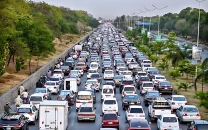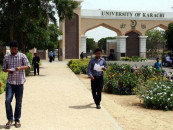People in villages in desperate need of clean drinking water
Twenty-three days ago, they had a home. Now, flood victims line the Grand Trunk Road which has become home.

“Aid arrives here in great quantity but the needy don’t get it,” says Rehmanullah, 45, who set up camp on the road on July 29. The GT Road divides the Nowshera district into north and south, and tents of displaced people from both the areas now dot the road. “The influential people who live on the southern side of the road are getting the major chunk of aid, even though the floods ravaged the northern side,” he says.
Rehmanullah’s nine-member family had managed to escape only with the clothes on their back and his three sons are overjoyed at having received donated shirts carrying the Australian cricket team’s colours. The women live in a camp set up in a nearby school, while the men are fending for themselves on the road.
Elderly Fazal Hussain spends his days and night without a tent. He produces a crumpled note from his pocket, which is a photocopy of a handwritten form asking the DCO to provide a tent to his family.
Those on the road, and in sight, get water. But those in the villages, and out of sight, have to go without even that.
Maarif Gul, a resident of Bella village, told The Express Tribune that they were using hand-pumps as there was no tap water in their village. “But we can’t use hand-pumps any longer as flood water has seeped into the core of the pumps, which extract water from a depth of 40 to 50 kilometres. The water that now comes out of the pump cannot be used for drinking,” he says.
Gul said that sewage was another major problem for the villagers as sewerage lines and other structures are heavily silted and villagers have resorted to using open air spaces, which could lead to the spread of disease.
In Bella village, which was populated by 300 people, everything is in ruins. The residents said that they had been given no intimation of the floods and barely managed to escape when they saw waters rising on July 29.
“Timely information by the authorities would definitely have helped. We could have saved some of our belongings,” said Badar Munir, another villager.
“There were heavy cattle head losses in our area. Close to the village, there was a farm owned by Haji Abdul Rehman and 85 buffalos were killed by the raging torrents,” he says. Another farmowner, Mohammad Noor, had lost 95 of his 125 buffaloes, said Munir.
The carcasses of dead cattle are still lying in the open which, Munir says, is partly responsible for the stench that has engulfed the area.
Near the village is a food store of the UN’s World Food Programme (WFP), which also suffered immense damage in the floods.
This facility employed most of the locals from the village who now collect soggy bags of wheat.
The WFP says that it is far from achieving its aim of providing one-month rations to six million people, and with these soggy bags of wheat, achieving the target does seem very, very difficult.
Published in The Express Tribune, August 21st, 2010.



















COMMENTS
Comments are moderated and generally will be posted if they are on-topic and not abusive.
For more information, please see our Comments FAQ